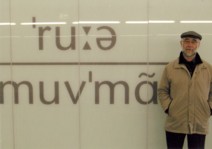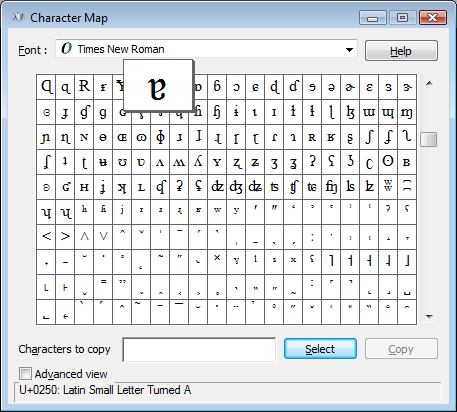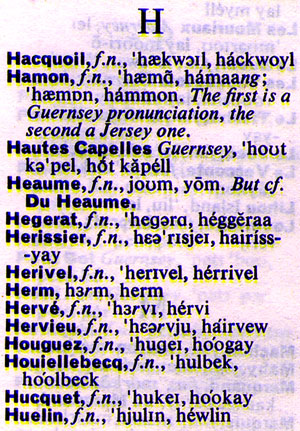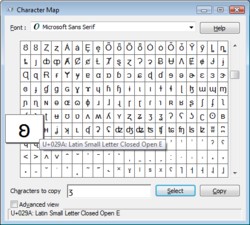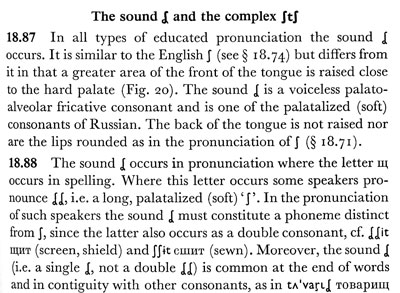DEPARTMENT OF SPEECH, HEARING & PHONETIC SCIENCES UCL Division of Psychology & Language Sciences |
 |
John Wells’s phonetic blog archive 1-15 March 2008To see the IPA phonetic symbols in the text, please ensure that you have installed a Unicode font that includes them all, for example Lucida Sans Unicode or Charis SIL (click name for free download). Browsers: I recommend Firefox (free) or, if you prefer, Opera (also free). email: |
|
Friday 14 March 2008 | A tour de forceThanks to Amy Stoller of the Vastavox discussion list for drawing to our attention this impressive tour of 21 accents in 2½ minutes, performed by one Amy Walker.
She covers English (London) mainstream RP, London Cockney, U-RP, Dublin, Belfast, some kind of Scottish (Glaswegian, I think); then non-native accents of English as spoken by an Italian, a German, a Czech, a Russian, and a Frenchwoman; then back to native English for general Australian, NZ, broad Australian, Texan, Californian, northwestern American (Seattle), Canadian, New York (Brooklyn), South Carolinan and — intriguingly — a mid-twentieth-century actressy ‘transatlantic’ accent reminiscent of countless old films. She does all of these accents remarkably well, and switches from one to another smoothly every few seconds. I thought her three London accents sounded entirely authentic. I wonder if she can do any kind of English northern accent (Brummie, Scouse, Mancunian, Yorkshire, Geordie...?). I’m not so sure about the second version of Australian. Worse, though, was the Canadian: I didn’t think it sounded right at all. There’s a spoof of it all here. Funny, but not quite so competent. |
|
Thursday 13 March 2008 | Transcription in the public eyeAt the time of the ICPhS in Saarbrücken last August the town’s railway station was in the middle of being refurbished. Now Jürgen Trouvain, the Local Organizer of the congress, writes to tell me: Soon after ICPhS, the renovated building of Saarbrücken central station was re-opened as a "Euro"-Bahnhof, now with very fast connections to Paris (1:50 hours Saarbrücken-Paris Gare de l'Est in comparison to four hours before). To our astonishment the only words visible on the walls of the hallway to the platforms are written in phonetic symbols: the German words Ruhe (=silence) and Innovation and the French words mouvement and tradition. With the exception of mouvement the words remain semantic question marks to us in a busy train station. |
|
Wednesday 12 March 2008 | More phonetic fonts in VistaIn Windows Vista I find that Microsoft Sans Serif is not the only font that has been extended to cover the IPA symbols (blog, 5 March). So have the very widely used Arial and Times New Roman. (The latter is not to be confused with the old non-Unicode Times New Roman Phonetics.)
In Arial, as you can see, the lax-i symbol, U+026A ɪ, the KIT vowel, is open to same objection as that in Microsoft Sans Serif : it needs serifs. Worse still, the shape of the old alternative symbol, U+0269 ɩ, is identical to U+026A, where it should rather have the curl of a Greek iota. Compare these letters in Arial (both bad), Microsoft Sans Serif (first OK, second bad), Arial Unicode MS (both OK) and Lucida Sans Unicode (both OK).
In Times New Roman the only letter-shape that I am really not satisfied with is the lax-u symbol, U+028A ʊ, the FOOT vowel. It looks too much like an inverted small cap omega. But its Unicode name is LATIN SMALL LETTER UPSILON. It ought not to have the stalks and extra serifs at the top. Compare this letter in three fonts: Times New Roman (bad), Doulos SIL (good), Times New Roman Phonetics (good).
Despite these minor cavils, it is very good news that these widely used and widely distributed fonts now contain the IPA symbols. The range of phonetic symbols covered in the expanded fonts is also greater than that in Lucida Sans Unicode, since the new fonts are based on Unicode version 5 (I think), while Lucida Sans Unicode was based on the more restricted version 2. The expanded fonts also cater for polytonic Greek, which the old Arial and Times New Roman did not. I’m looking forward to the day when we can display phonetic symbols in Comic Sans MS! |
Tuesday 11 March 2008 | Jersey hJersey, in the Channel Islands, is in the news at the moment because of a child abuse scandal. The former children’s home under investigation is called Haut de la Garenne, in the parish of St Martin. It is striking that radio and television newsreaders pronounce this place with initial h, despite the fact that they must all be aware that in French the letter h at the beginning of a word is silent. Indeed, all British newsreaders must certainly know enough French to be aware that the French for ‘high’, haut, is pronounced o. (Let’s not get involved in the question of so-called h aspiré.) The BBC Pronunciation Unit tell me Yes, our newsreaders are following our advice by pronouncing the h-. Although the 1990 BBC Pronouncing Dictionary of British Names does not include any entry for Haut de la Garenne, its Channel Islands Appendix does list fourteen French-looking names spelt with h-. Thirteen of them are pronounced with h.
I don’t know anything about Jèrriais (French jersiais), the Norman French dialect of Jersey, but presumably it has retained historical h despite the disappearance of h from standard French. Or is it to be explained as spelling pronunciation, like the h in Terre Haute, Indiana? I am told that the BBC Pronunciation Unit has just sent round a reminder to all broadcasters that Beijing is properly pronounced with dʒɪŋ, not ʒɪŋ. I say the same thing in LPD. I wonder how much effect we will have. |
|
Monday 10 March 2008 | CamillaListening on Saturday to the live coverage on ZJB Radio Montserrat of the royal visit to the island by Prince Charles and his wife Camilla, I was struck by the fact that the commentator consistently pronounced her name with initial stress, as ˈkæmɪlə. Proper names are a minefield for any radio or TV commentator, but there’s a pretty clear spelling-to-sound rule for any word or name spelt -illa: it has penultimate stress. Consider Priscilla, cedilla, chinchilla, vanilla, gorilla, guerilla, scintilla, flotilla, even tortilla. Indeed, consider the nearby island Anguilla. As far as I can tell, there are no counterexamples. So if Camilla is a name you don’t know, there is every reason to suppose, on the basis of the spelling, that it is pronounced kəˈmɪlə. Which it normally is. This rule is part of a more general rule that any word with a vowel letter followed by two consonant letters and a bears penultimate stress. So umbrella, propaganda, veranda, agenda, anaconda, alfalfa, charisma, dilemma, antenna, catalpa, magenta, vendetta, bonanza, cadenza and so on. Exceptions: algebra, vertebra. Even odder, with three consonants before the a, is orchestra. The announcer doing the commentary was the highly accomplished Rose Willock (scroll right down here). She was awarded the OBE for her broadcasting skills keeping the community together during the darkest days of Montserrat’s volcanic eruption. Strange that she should have this blind spot. Perhaps she was thinking of camel. |
|
Friday 7 March 2008 | Are you asking me or telling me?English intonation is not very good at making clear whether an utterance is a statement or a question. (1) So he’s 'right. (2) So he’s 'right? The statement, (1), is typically said with a fall. (1′) So he’s \right. But it can also have a rise, to show truculence or mere non-finality (not to mention the new fashion of uptalk). (1″) So he’s /right, | what\ever you say. The yes-no question, (2), ‘so do you mean he’s right?’ is said by default with a rise. (2′) So he’s /right? | Is /that what you mean? But it can also have a fall, if presented as a kind of challenge to the interlocutor. (2″) So he’s \right!? | Is \that what you mean!? You could also use a fall-rise, in either meaning... Nicholas Widdows writes: I heard an interesting example of contrastive intonations at the pub tonight. Someone asked 'What wines do you serve by the glass?' and the barman asked 'White or red?', but the customer misheard it as an uninformative answer 'White or red'. |
|
|
Several correspondents have commented on my discussion of the intonation of the counterpresuppositional sentence You’re 'on the window side or You 'are on the window side (blog, 19 February). The consensus among native speakers seems to be that the first pattern, the one I felt unhappy with in context, is nevertheless possible. So it’s comparable to A: Never 'mind. | Worse things happen at 'sea. (p. 183 in my English Intonation book). Christopher Bergmann took up the issue in his own blog. He points out there that in German you cannot put the nucleus on the preposition in such cases. A: Ich möchte auf der 'Fensterseite sitzen. and not B: *Aber du sitzt doch 'auf der Fensterseite! The only reason you would put the nucleus on the preposition would be for contrast. That would be pretty impossible to contextualize here: not on the window side but ??? below/beyond/outside it. |
|
Thursday 6 March 2008 | IPA reforms, 1976In 1976 the IPA Council voted to add a number of symbols to the Chart, notably ʘ, ʝ and ɰ, which we use to this day. At the same time it withdrew recognition from various symbols that had never been widely taken up, including some we have just discussed (blog, 4 March).
The IPA has recommended various palatalization diacritics over the years. The old dot above, as in ṫ (impractical — you can probably hardly see it), was retained in 1928 as an optional alternative when the attached j-shaped hook, as in ƫ, was adopted. From 1976 to 1989 the hook was the only approved way of showing palatalization, other than possibly by a digraph (tj); but it in turn was superseded at the 1989 Kiel Convention by the raised j that we use now, as in tʲ. Until 1976 the symbols ƾ and ƻ had appeared in the Chart as standing for the voiceless and voiced alveolar affricates. I have never seen them actually in use except in the 1949 booklet The Principles of the IPA, in the transcription of Georgian, where the first two lines have the words ƾʼamosxmulma and ƻlieri. Nowadays we write t͡s d͡z, with a combining tie bar, or just ts dz. (You may occasionally also see ʦ ʣ, though these ligatures are not actually IPA-approved.) The third letter stood for the Japanese moraic nasal, a phonological unit with various possible nasal and nasalized realizations. In accordance with the principle of simplicity, it is usually sufficient to write it as ɴ or indeed n (provided you distinguish it from syllable-initial n in some way). If relevant we can also use various narrower symbols as appropriate, e.g. m, n, ŋ, ɯ̃. (There is a Unicode number for this disused symbol, U+019E LATIN SMALL LETTER N WITH LONG RIGHT LEG, but the glyph in Lucida Sans Unicode is wrong. It’s OK in Doulos SIL.) For the r-colouring modifier the IPA now recognizes a retroflex hook higher up, thus ə˞ ɛ˞ a˞. The symbols ɚ ɝ, which include this diacritic, were first introduced by Kenyon and Knott in their Pronouncing Dictionary of American English, 1944, and have been in widespread use since then. | ʘ ʝ ɰ ƾ ƻ |
Wednesday 5 March 2008 | Microsoft Sans SerifI have recently acquired a new computer, which has given me my first experience of Windows Vista. Among many other interesting features, I found that it came with a phonetic font I had not seen before: Microsoft Sans Serif. As Wikipedia explains, Microsoft Sans Serif is a TrueType variant of MS Sans Serif sold by Ascender Corporation, and is found in Windows 2000 and later. Version 1.41 of the font includes 2,257 glyphs covering extended Latin characters (including IPA extensions), diacritical marks, Greek (with extensions), Coptic, Cyrillic, Hebrew (including extensions), Arabic (including extension, presentation forms), Thai, international currency, and mathematical symbols. This font also contains most glyphs shipped with any version of Windows, excluding fonts supporting East Asian ideographs. Here’s what the phonetic symbols look like in this font.
Not bad, and a welcome addition to our range of phonetic fonts, but not perfect either. The designer has taken too literally the Unicode name for the cardinal 5 symbol, ɑ, LATIN LETTER SMALL ALPHA. Maybe the IPA ought to have lobbied to retain the earlier Unicode name, LATIN SMALL LETTER SCRIPT A. (The Handbook of the IPA calls it simply Script A.) Because in this font it looks much too like an alpha, written with a single looping stroke (see specimen above), which is not how we write the phonetic symbol. The same applies to its inverted counterpart, ɒ, LATIN SMALL LETTER TURNED ALPHA, cardinal 13. The proportions of the symbol for the voiced palatoalveolar fricative ʒ are a bit odd, too. The other big criticism I would make is the absence of serifs on the lax-i symbol ɪ. It was dissatisfaction with the sans serif form of this symbol that led the IPA in 1943 to recognize ɩ as an alternative. (Recognition was withdrawn in 1989.) Other current sans serif phonetic fonts rightly retain the serifs in this symbol. The serifs must be treated as an integral, indispensable part of the character. Both Arial Unicode MS and Lucida Sans Unicode got these points right. I sent an email to the typographers, Ascender Corporation, and they replied within a few hours saying they would “log these comments as a bug against the font for investigation”. Thanks, guys. |
|
Tuesday 4 March 2008 | Palatoalveolars and the likeFollowing on from yesterday’s discussion of alveolopalatals, palatoalveolars and postalveolars, we might note some other phonetic symbols for this general type of sound — symbols at one time approved by the IPA but from which recognition has since been withdrawn. In the early days of the IPA, the symbols σ ƍ ƪ ƺ were approved for labialized sibilants which we would nowadays probably write sʷ zʷ ʃʷ ʒʷ. The title of Daniel Jones’s Sechuana Reader (1916) reads ɺipɑlɔ tsɑ̄-sɪ̶cƪɑ̀ːnɑ̱. Apart from this, I don’t think they were ever used very much. By 1949, when the Principles of the IPA booklet was published, Jones recommended sf, sv or sɥ, zɥ instead of σ ƍ for the ‘whistling fricatives’ of Shona, which are adequately reflected in the orthography as sv, zv. (Coleman, though, regards the voiceless one as a simultaneous ɸ and s.) In the same booklet Jones wrote the Tswana sound he had formerly written ƪ (‘a single sound having a peculiar type of lip-rounding involving an articulation by the inside of the lower lip against the upper teeth’) as ʃw. Recognition of all these earlier symbols was finally withdrawn in 1976. Now you know how to pronounce the Zimbabwean politician Morgan Tsvangirai’s name. In 1947 the IPA approved two symbols to stand for palatalized ʃ, ʒ (“for use when these occur as phonemes separate from non-palatalised ʃ, ʒ”). They were ʆ and ʓ. Daniel Jones (posthumously) and Dennis Ward used these symbols in their book The Phonetics of Russian (CUP 1969).
As far as I can see the symbols ʆ and ʓ are more or less synonymous with ɕ, ʑ. In any case for Russian they could be written ʃʲ, ʒʲ. Recognition was withdrawn at the IPA Kiel Convention in 1989. | ʆ ʓ σ ƍ ƪ ƺ
|
Monday 3 March 2008 | AlveolopalatalsTwo sounds/symbols that I forgot to mention in my posting about ‘dead letters’ (20 Feb) are ɕ and ʑ, the alveolopalatal fricatives. Listed under “other symbols” on the Chart, these are nevertheless two sounds that the examination candidate does need to be familiar with. Jussi Wikström writes, Some American phonetics textbooks refer to (American) English post-alveolars as alveolo-palatals rather than post-alveolars or palato-alveolars. An Australian linguist and trained phonetician tells me that most (if not all) Australian accents of English have alveolo-palatals, whereas RP has post-alveolars. I suspect that this may be just a difference of terminology, without any significant difference in the sounds referred to. I can’t say I have ever noticed much of a difference between Australian or American tʃ dʒ and my own. Like many other phoneticians, I do not follow the post-Kiel IPA Chart in classifying tʃ dʒ as “post-alveolar”. For me, the English affricates that are postalveolar are the ones in trace and drab, while those in chase and jab remain palatoalveolar. Jussi writes further, Could you perhaps advise me as to how I could make the distinction between alveolo-palatal and palato-alveolar so that my articulations of those sounds will be accepted in phonetics examinations? Would you agree that alveolo-palatals tend to be produced with the tongue-tip behind the lower teeth or at the interdental place of articulation whereas in palato-alveolars the tongue-tip is somewhere behind the alveolar ridge (which gives a darker quality)? Hm. One difference between ɕ ʑ tɕ dʑ and ʃ ʒ tʃ dʒ is certainly that the fricatives and affricates in the latter of these two sets of four sound “darker” than those in the former. But I’m not so sure about this suggested difference of tongue position. One of the exercises I used to do with students was to make them slide back and forth along the continuum ɕ — ʃ — ʂ. |
current blog
Archived from previous months:
To search my web pages, use this Google search.


